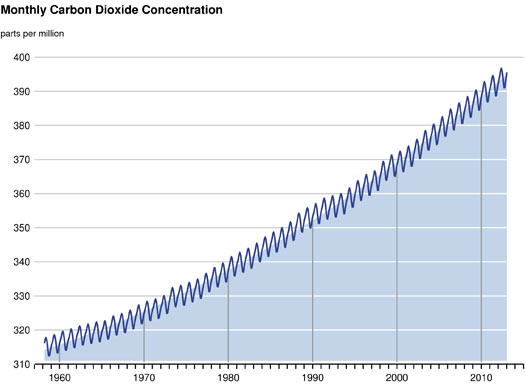We’re About to Pass a Disheartening New Climate Change Milestone
We’re teetering on the edge of hitting carbon dioxide levels of 400 ppm, but will that be enough to change minds and policies?

We’ll likely hit a CO2 milestone of 400 ppm sometime this month. Photo: Scripps Institution of Oceanography
For the first time in human history, later this month the world’s atmospheric levels of carbon dioxide will likely exceed 400 parts per million, according to a study conducted by the Scripps Institution of Oceanography. The researchers monitor CO2 concentrations from a station in Hawaii, and those levels usually peak in May. Right now, levels are teetering at 399 ppm. If they do not exceed 400 ppm this year, the researchers say, they almost certainly will next year.
In March 1958, when the first measurements of atmospheric CO2 were made, the northern hemisphere stood at 316 ppm. Researchers project that the pre-industrial atmosphere was around 280 ppm. For the past 800,000 years prior to the industrial revolution, Scripps points out, CO2 levels never exceeded 300 ppm. At this rate, however, we’re likely to hit 450 ppm within the next few decades. “With global emissions showing no sign of slowing, it may well be that within our lifetimes we look back on 400 ppm as a fond memory,” muses the Carbon Brief.
This landmark is more symbolically the scientifically significant, however. The International Herald Tribune points out:
While the milestone is arbitrary (why is hitting 400 parts per million more alarming than a measurement of 399?), scientists say it’s an important reminder of how the levels continue to rise.
Regardless of whether we’re at 390 or 400 ppm, the fact is that atmospheric levels of carbon dioxide are rising are projected to continue to do so. Some researchers and advocates hope that crossing the 400 ppm threshold will help kick politicians and the public into action since climate change is just as much a political issue as a scientific one these days. Responding to Climate Change writes:
Let us hope that reaching 400ppm can serve as a spark to ignite a new sense of urgency about climate change. Otherwise, in a few decades, we’ll lament our inaction when we hit 450ppm.
But there’s no guarantee or even hint that this latest development will cause significant ripples in policy, attitude or action. Indeed, the station in Hawaii that monitors CO2 levels is in danger of shutting down because of budget cuts and the perception that the research conducted there is not essential, reports Nature News. “It’s kind of silly that we chose to go all ostrich-like,” biogeochemist Jim White told Nature. “We don’t want to know how much CO is in the atmosphere, when we ought to be monitoring even more.”
More from Smithsonian.com:
Plants Won’t Help Fight Global Warming as Much as We Thought
The Carbon Dioxide in a Crowded Room Can Make You Dumber
/https://tf-cmsv2-smithsonianmag-media.s3.amazonaws.com/accounts/headshot/Rachel-Nuwer-240.jpg)
/https://tf-cmsv2-smithsonianmag-media.s3.amazonaws.com/accounts/headshot/Rachel-Nuwer-240.jpg)